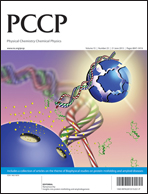Initiation of assembly of tau(273-284) and its ΔK280 mutant: an experimental and computational study†
Abstract
The microtubule associated protein tau is essential for the development and maintenance of the nervous system. Tau dysfunction is associated with a class of diseases called tauopathies, in which tau is found in an aggregated form. This paper focuses on a small aggregating fragment of tau, 273GKVQIINKKLDL284, encompassing the (PHF6*) region that plays a central role in tau aggregation. Using a combination of simulations and experiments, we probe the self-assembly of this peptide, with an emphasis on characterizing the early steps of aggregation. Ion-mobility mass spectrometry experiments provide a size distribution of early oligomers, TEM studies provide a time course of aggregation, and enhanced sampling molecular dynamics simulations provide atomistically detailed structural information about this intrinsically disordered peptide. Our studies indicate that a point mutation, as well the addition of heparin, lead to a shift in the conformations populated by the earliest oligomers, affecting the kinetics of subsequent fibril formation as well as the morphology of the resulting aggregates. In particular, a mutant associated with a K280 deletion (a mutation that causes a heritable form of neurodegeneration/dementia in the context of full length tau) is seen to aggregate more readily than its wild-type counterpart. Simulations and experiment reveal that the ΔK280 mutant peptide adopts extended conformations to a greater extent than the wild-type peptide, facilitating aggregation through the pre-structuring of the peptide into a fibril-competent structure.

- This article is part of the themed collection: Biophysical studies on protein misfolding and amyloid diseases

 Please wait while we load your content...
Please wait while we load your content...